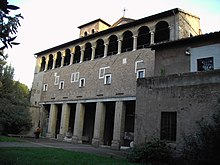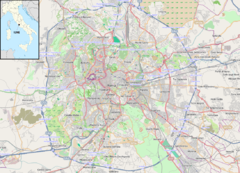San Saba, Rome
This article needs additional citations for verification. (March 2016) |
| Basilica of San Saba | |
|---|---|
 Facade | |
| Religion | |
| Affiliation | Roman Catholic |
| Province | Rome |
| Rite | Roman Rite |
| Patron | Sabbas the Sanctified |
| Location | |
| Location | Piazza Gian Lorenzo Bernini 20, Rome, Italy |
 Shown within Rome | |
| Geographic coordinates | 41°52′43″N 12°29′08″E / 41.878638°N 12.485542°ECoordinates: 41°52′43″N 12°29′08″E / 41.878638°N 12.485542°E |
| Architecture | |
| Type | Church |
| Style | Romanesque |
| Completed | 13th century |
| Website | |
| sansaba | |
San Saba is an ancient basilica church in Rome, Italy. It lies on the so-called Piccolo Aventino, which is an area close to the ancient Aurelian Walls next to the Aventine Hill and Caelian Hill.
The current Cardinal Deacon of the Titulus S. Sabae is Jorge Medina Estévez. The titulus was established in 1959.
History[]
According to legend, St. Silvia, mother of Pope Gregory I, had an estate at the site. After her death, so legend reads, her estate was transformed into an affiliate monastery of St. Andreas, the monastery which Gregory I founded at the site of today's San Gregorio al Celio. This legend, however, can be traced back only to the 12th century, when in context of Renovatio Romae and Church Reform, the monastery of San Saba was meant to be provided with a long and impressive local tradition.

The historic origin of the religious site goes back to the year 645. In this year, fugitive monks from the monastery of St. Sabas (Mar Saba, Palestine), who had fled their home country after the Islamic invasion, came to Rome to attend the Lateran Council. After the council, these Sabaite monks settled down in an old domus (=noble estate) on the "Piccolo Aventino" (the smaller crest of the Aventine hill, which at this time was deserted due to the big decrease in Rome's population. Here, they founded an eremitic cell. The Sabaites introduced the cult of St. Sabas to Rome. In ancient sources, their monastery however goes by the name cellas novas or cellaenovae, which refers to the cellae (=cells) of their mother abbey, Mar Saba.
The Sabaite monastery prospered quickly and for a long time. In the 8th and 9th centuries, San Saba was one of the most prestigious of Rome and among the leading "Greek" monasteries. It received rich papal donations. Since 680, its abbots held important diplomatic roles in the relationships between Rome and Byzantium, and represented the Roman Church and Pope at several church councils in Constantinople.
In 768, Antipope Constantine II was held prisoner in this monastery, before being killed by the Lombards.
The Benedictine monks of Monte Cassino received the church after it was rebuilt in the 10th century. Anselm, the nephew of St Anselm, was one of its abbots before departing to England as a papal legate. After many years of decay, the basilica was completely renovated in the 13th century, after being ceded to Cluniac monks in 1144.[1] In 1503 the Cistercians were entrusted with the church, which in 1573 was finally conveyed to the Jesuits (and their German seminary Collegium Germanicum et Hungaricum).
Structure[]
The church, preceded by a small porch from the 13th century, has a nave with two aisles. These end with three apses. The interior is characterized by numerous interventions from different ages. The columns are from ancient buildings, and the floor is an example of Cosmatesque marble art from the beginning of the 13th century. The main artpieces are the notable frescoes in a room on the left side of the church, the so-called fourth nave: they portray the miracles of St. Nicholas.
The crypt, built on the house of St. Silvia, holds the relics of St. Sabas. The sacristy houses a fragment of fresco from the very first church (8th century).
References[]
- ^ Cannizzaro, p. 241.
Bibliography[]
- Daniela Gallavotti Cavallero, S. Saba (Rome; Ist. Nazionale di Studi Romani, 1988).
- Richard Krautheimer, Corpus Basilicarum Christianarum Romae: The Early Christian Basilicas of Rome (IV-IX Cent.) Part IV (Rome: Pontificio istituto di archeologia cristiana, 1937), pp. 51 ff.
- M. E. Cannizzaro, " L'antica chiesa di S. Saba sull'Aventino ", Atti del II Congresso Internazionale di Archeologia Cristiana (Rome, 1900), p. 241–248.
External links[]
- "San Saba", Nyborg.
| Wikimedia Commons has media related to San Saba. |
- Basilica churches in Rome
- Titular churches
- 10th-century churches in Italy
- Churches of Rome (rione San Saba)


